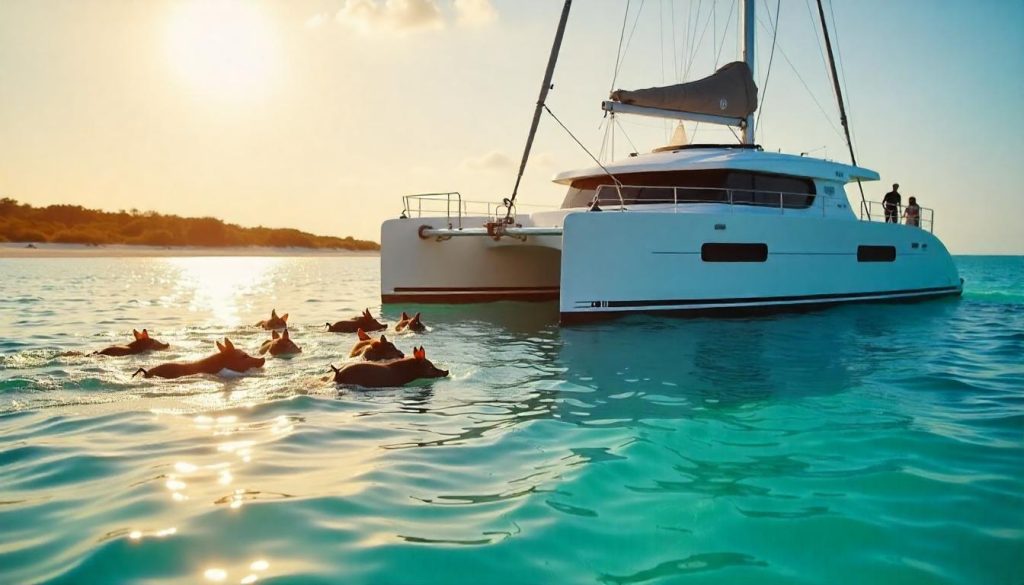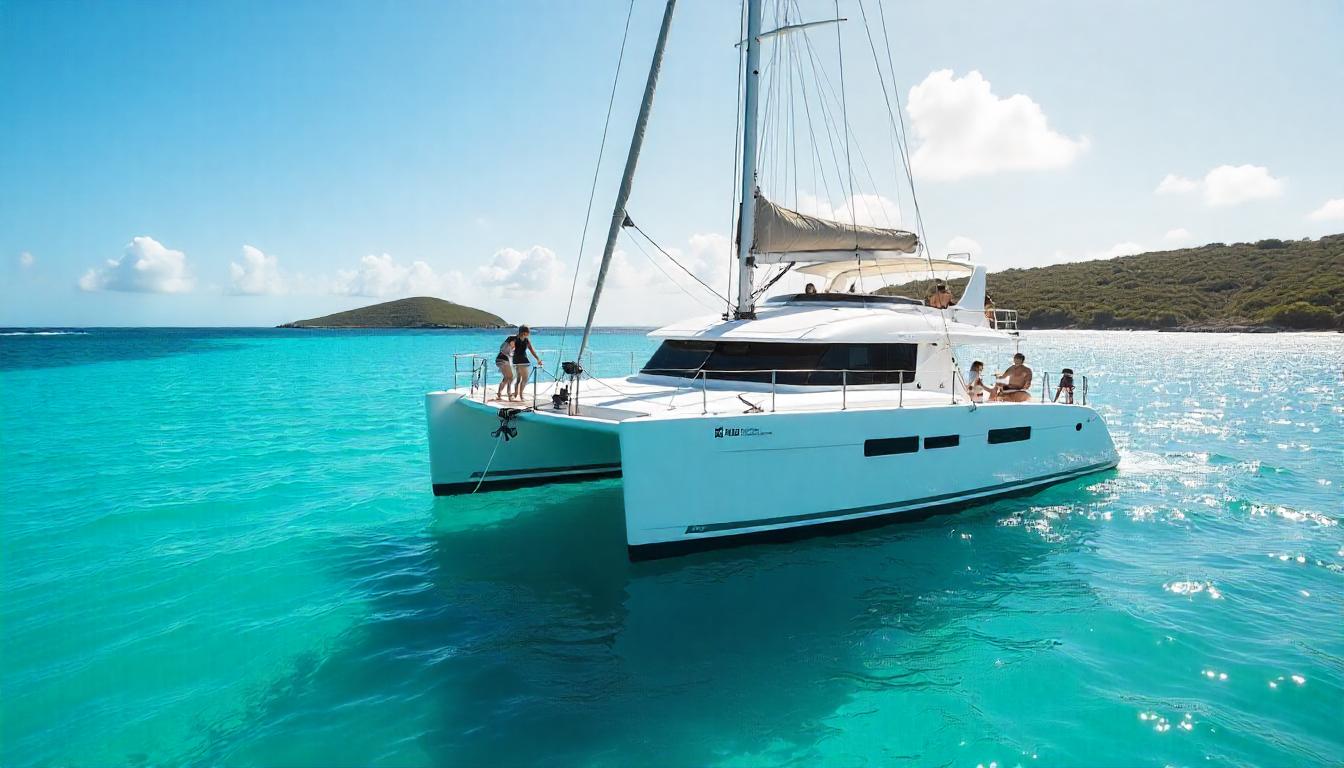The Caribbean, with its turquoise waters and scattered islands, is a dream destination for sailors, and Caribbean yachting in 2025 offers a chance to discover hidden cays that few travelers reach. Spanning over 2,500 miles across the Atlantic, this region includes more than 7,000 islands, cays, and reefs, each with its own charm. From the Bahamas’ untouched sands to the Grenadines’ secluded anchorages, the Caribbean blends adventure with serenity. In this guide, we’ll explore top routes, uncover lesser-known cays, and share practical tips for an unforgettable sailing journey. Let’s dive into the Caribbean’s secret gems.
Bahamas: A Gateway to Caribbean Yachting
The Bahamas, with over 700 islands, serves as a gateway to Caribbean yachting, offering endless opportunities for exploration. Start your journey in Nassau, the capital, which has a well-equipped marina. For example, Nassau Harbour accommodates yachts up to 60 meters. It has 100 berths and depths of 5-7 meters, per port data. Also, the marina provides fuel and provisioning services. You can explore Nassau’s vibrant Straw Market, where vendors sell handmade baskets for $15. The area’s winds average 10 knots, per forecasts. Thus, the Bahamas are a perfect starting point for yachters.
Exuma Cays: A Pristine Escape for Sailors
The Exuma Cays in the Bahamas offer a pristine escape for sailors seeking solitude. Anchor near Staniel Cay in depths of 4-6 meters, suitable for yachts up to 40 meters, per charts. For instance, the cay’s waters average 26°C, ideal for swimming. Visibility reaches 20 meters, per marine reports. Also, Thunderball Grotto, a nearby cave, is famous for its underwater scenes in a James Bond film. Snorkeling tours cost $25 per person, per operators. You can spot nurse sharks and tropical fish. Additionally, Staniel Cay’s Yacht Club serves conch fritters for $15, per their menu. This untouched spot makes the Exuma Cays a highlight. Therefore, it’s a must-visit for sailors in the Bahamas.
Pig Beach: A Unique Encounter in the Exumas
Pig Beach, also near Staniel Cay, provides a unique encounter for sailors in the Exumas. Anchor offshore in depths of 3-5 meters, suitable for yachts up to 30 meters, per data. For example, this beach on Big Major Cay is home to swimming pigs. They greet visitors, making it a quirky stop, per local guides. Also, the waters average 26°C, perfect for swimming with the pigs. Visibility is up to 15 meters, per reports. You should bring biodegradable snacks to feed the pigs, as they’re used to visitors, per advice. Moreover, the beach’s white sands and calm waters create a surreal setting. This unusual spot makes Pig Beach a standout. Thus, it’s a fun detour for yachters in the Bahamas.
British Virgin Islands: A Classic Caribbean Yachting Route
The British Virgin Islands (BVI), with their sheltered bays, offer a classic Caribbean yachting route for sailors of all levels. Begin in Tortola, the largest island, at Road Harbour Marina. This marina accommodates yachts up to 50 meters. It has 80 berths and depths of 5-7 meters, per port data. For instance, berthing fees average $90 per night for a 40-meter yacht. Amenities include fuel and Wi-Fi, per tariffs. Also, Tortola’s Callwood Distillery sells aged rum for $20, reflecting local traditions. The area’s winds average 12 knots, per forecasts. Thus, the BVI are ideal for a balanced sailing experience.
Anegada: A Remote Cay with Lobster Dinners
Anegada, the northernmost BVI, is a remote cay known for its lobster dinners. Anchor near Setting Point in depths of 4-6 meters, suitable for yachts up to 40 meters, per charts. For example, the island’s flats make navigation tricky, so use updated charts, as depths can drop to 2 meters, per data. Also, Anegada Lobster Restaurant serves fresh lobster for $35, caught daily, per their menu. The waters average 27°C, ideal for snorkeling, with visibility up to 25 meters, per reports. You can explore the island’s flamingo-filled salt ponds, a natural spectacle, per guides. Moreover, the area’s winds average 10 knots, per forecasts. This remote cay makes Anegada a highlight. Therefore, it’s a top stop for sailors in the BVI.
The Baths: A Geological Wonder in Virgin Gorda
The Baths in Virgin Gorda offer a geological wonder for sailors in the BVI. Anchor offshore in depths of 5-7 meters, suitable for yachts up to 50 meters, per data. For instance, this beach features giant granite boulders forming natural pools and grottos, per guides. Also, the waters average 27°C, perfect for swimming through the caves. Visibility reaches 20 meters, per reports. A trail through the boulders leads to Devil’s Bay, a secluded beach, with no entry fee, per park rules. You should wear water shoes, as the rocks can be slippery, per advice. Additionally, the area’s calm waters ensure a safe stop, per forecasts. This natural wonder makes The Baths a standout. Thus, it’s a must-visit for yachters in the BVI.

Grenadines: A Hidden Gem for Caribbean Yachting
The Grenadines, a chain of islands in the southern Caribbean, are a hidden gem for Caribbean yachting, offering untouched beauty. Start in Bequia, a quaint island with a small marina. Admiralty Bay in Bequia accommodates yachts up to 40 meters. It has depths of 4-6 meters, per port data. For example, berthing fees average $60 per night for a 40-meter yacht. Amenities include fuel, per tariffs. Also, Bequia’s Port Elizabeth has markets selling local spices for $5, per vendors. The area’s winds average 8 knots, per forecasts. Thus, the Grenadines are perfect for off-the-beaten-path sailing.
Tobago Cays: A Marine Park Paradise
Tobago Cays, a marine park in the Grenadines, offer a paradise for sailors seeking nature. Anchor near Horseshoe Reef in depths of 5-7 meters, suitable for yachts up to 40 meters, per charts. For instance, the park’s waters average 28°C, ideal for snorkeling with sea turtles, per reports. Visibility reaches 30 meters, making it a diver’s dream, per data. Also, the park has no facilities, so bring your own supplies, per guides. You can barbecue on your yacht, with local fish markets in Bequia selling snapper for $10 per kilo, per vendors. Moreover, the area’s winds average 7 knots, per forecasts. This marine haven makes Tobago Cays a highlight. Therefore, it’s a top spot for sailors in the Grenadines.
Mayreau: A Quiet Retreat in the Grenadines
Mayreau, the smallest inhabited Grenadine island, provides a quiet retreat for sailors. Anchor in Salt Whistle Bay in depths of 4-6 meters, suitable for yachts up to 40 meters, per data. For example, the bay’s crescent beach has palm trees and waters averaging 28°C, per reports. Also, a short hike to the village offers views of Tobago Cays, with a small church as the highlight, per guides. Local bars like Robert Righteous serve rum punch for $8, per their menu. You can swim in the calm bay, with visibility up to 20 meters, per reports. Additionally, the area’s winds average 6 knots, per forecasts. This peaceful spot makes Mayreau a standout. Thus, it’s a great retreat for yachters in the Grenadines.
Antigua and Barbuda: A Cultural Stop for Sailors
Antigua and Barbuda offer a cultural stop for sailors exploring the Caribbean, with history and vibrant events. Begin in Antigua at Nelson’s Dockyard Marina, a historic site. This marina accommodates yachts up to 60 meters. It has 50 berths and depths of 5-7 meters, per data. For instance, berthing fees average $100 per night for a 40-meter yacht. Amenities include fuel and laundry, per tariffs. Also, the dockyard, a UNESCO site, hosts events like the Antigua Sailing Week, per guides. The area’s winds average 10 knots, per forecasts. Thus, Antigua is a cultural hub for yachters.
English Harbour: A Historic Anchorage
English Harbour in Antigua offers a historic anchorage for sailors. Anchor near Nelson’s Dockyard in depths of 5-7 meters, suitable for yachts up to 50 meters, per charts. For example, the dockyard, built in the 18th century, features Georgian architecture, with entry at $10, per guides. Also, the harbor’s waters average 27°C, ideal for swimming, per reports. Local restaurants like Catherine’s Café serve lobster salad for $30, per their menu. You can hike to Shirley Heights for sunset views, with entry at $5, per guides. Moreover, the area’s winds average 9 knots, per forecasts. This historic spot makes English Harbour a highlight. Therefore, it’s a top stop for sailors in Antigua.
Barbuda: A Pink Sand Beach Haven
Barbuda, Antigua’s sister island, offers a pink sand beach haven for sailors. Anchor near Princess Diana Beach in depths of 4-6 meters, suitable for yachts up to 40 meters, per data. For instance, the beach’s pink hue comes from crushed coral, creating a stunning view, per guides. Also, the waters average 27°C, perfect for swimming, with visibility up to 25 meters, per reports. You can visit the Frigate Bird Sanctuary by tender, with tours at $20 per person, per operators. The island has few facilities, so bring supplies, per advice. Additionally, the area’s winds average 8 knots, per forecasts. This serene beach makes Barbuda a standout. Thus, it’s a must-visit for yachters in the region.
Practical Tips for Caribbean Yachting
Caribbean yachting in 2025 requires careful planning to ensure a safe journey. For example, the best time to sail is November to April, when the weather is dry, per Caribbean climate data. Also, book marina berths in advance, especially in Tortola and Antigua, as spaces fill up during peak season, per port advice. You should carry updated charts, as shallow reefs, like those in the Exuma Cays, can be hazardous, per data. Additionally, pack reef-safe sunscreen to protect marine ecosystems, per environmental guidelines. Thus, preparation ensures a seamless sailing experience.
Best Time to Sail the Caribbean
Timing your sailing trip enhances your Caribbean experience. November to April offers the best conditions, with dry weather and temperatures averaging 27°C, per forecasts. For instance, January is ideal for exploring Tobago Cays, with minimal rain, per data. However, the hurricane season, June to November, brings risks, with storms possible in the BVI, per reports. Also, the shoulder months, November and April, have fewer crowds, making anchorages like Mayreau quieter, per guides. Winds average 10-15 knots during the dry season, per forecasts. Therefore, the dry season is the best time for sailing.
Navigating the Caribbean Safely
Navigating the Caribbean safely ensures a worry-free trip. For example, shallow reefs in the Bahamas need updated charts, as depths can drop to 2 meters, per data. Also, local guides in Bequia cost $50 per day, helping navigate tricky areas like Anegada’s flats, per guidelines. You should monitor VHF channel 16 for weather updates, as fines for non-compliance can reach $200, per Caribbean law. Additionally, avoid anchoring in marine parks like Tobago Cays without permission, per regulations. This preparation keeps your journey smooth. Thus, navigation tools and local expertise are essential.
Conclusion: Caribbean Yachting in 2025
Caribbean yachting in 2025 offers an extraordinary adventure, uncovering hidden cays across the region. The Bahamas provide pristine escapes like the Exuma Cays. The BVI offer classic routes with stops like Anegada. The Grenadines reveal untouched beauty in Tobago Cays, while Antigua and Barbuda add cultural depth with English Harbour. Also, careful planning ensures a safe and memorable journey through these turquoise waters. Thus, set sail in 2025 and discover why the Caribbean remains a yachter’s paradise, blending adventure and serenity in one unforgettable trip.


